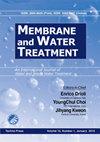Multi-objective optimization of stormwater pipe networks and on-line stormwater treatment devices in an ultra-urban setting
IF 1.1
4区 工程技术
Q4 ENGINEERING, CHEMICAL
引用次数: 0
Abstract
In a highly urbanized area, land availability is limited for the installation of space consuming stormwater systems for best management practices (BMPs), leading to the consideration of underground stormwater treatment devices connected to the stormwater pipe system. The configuration of a stormwater pipe network determines the hydrological and pollutant transport characteristics of the stormwater discharged through the pipe network, and thus should be an important design consideration for effective management of stormwater quantity and quality. This article presents a multi-objective optimization approach for designing a stormwater pipe network with on-line stormwater treatment devices to achieve an optimal trade-off between the total installation cost and the annual removal efficiency of total suspended solids (TSS). The Non-dominated Sorted Genetic Algorithm-II (NSGA-II) was adapted to solve the multi-objective optimization problem. The study site used to demonstrate the developed approach was a commercial area that has an existing pipe network with eight outfalls into an adjacent stream in Yongin City, South Korea. The stormwater management model (SWMM) was calibrated based on the data obtained from a subcatchment within the study area and was further used to simulate the flow rates and TSS discharge rates through a given pipe network for the entire study area. In the simulation, an underground stormwater treatment device was assumed to be installed at each outfall and sized proportional to the average flow rate at the outfall. The total installation cost for the pipes and underground devices was estimated based on empirical formulas using the flow rates and TSS discharge rates simulated by the SWMM. In the demonstration example, the installation cost could be reduced by up to 9% while the annual TSS removal efficiency could be increased by 4% compared to the original pipe network configuration. The annual TSS removal efficiency was relatively insensitive to the total installation cost in the Pareto-optimal solutions of the pipe network design. The results suggested that the installation cost of the pipes and stormwater treatment devices can be substantially reduced without significantly compromising the pollutant removal efficiency when the pipe network is optimally designed.超城市环境下雨水管网和在线雨水处理装置的多目标优化
在高度城市化的地区,为实现最佳管理实践(BMPs)而安装消耗空间的雨水系统的可用土地有限,因此需要考虑连接到雨水管道系统的地下雨水处理装置。雨水管网的配置决定了通过管网排放的雨水的水文和污染物运移特性,因此应成为有效管理雨水数量和质量的重要设计考虑因素。本文提出了一种多目标优化方法,用于设计具有在线雨水处理装置的雨水管网,以实现总安装成本与总悬浮物(TSS)年去除效率之间的最佳权衡。采用非支配排序遗传算法(NSGA-II)求解多目标优化问题。用于演示开发方法的研究地点是韩国龙仁市的一个商业区,该商业区现有管网有八个出水口,流入邻近的河流。雨水管理模型(SWMM)是根据研究区内的一个小集水区的数据进行校准的,并进一步用于模拟整个研究区内通过给定管网的流量和TSS排放率。在模拟中,假设在每个出口安装一个地下雨水处理装置,其大小与出口的平均流量成正比。利用SWMM模拟的流量和TSS流量,根据经验公式估算管道和地下装置的总安装成本。在演示示例中,与原始管网配置相比,安装成本可降低9%,而年TSS去除效率可提高4%。在管网设计的pareto最优解中,TSS的年清除效率对总安装成本相对不敏感。结果表明,管网优化设计可以在不影响污染物去除效率的前提下大幅度降低管道和雨水处理装置的安装成本。
本文章由计算机程序翻译,如有差异,请以英文原文为准。
求助全文
约1分钟内获得全文
求助全文
来源期刊

Membrane Water Treatment
ENGINEERING, CHEMICAL-WATER RESOURCES
CiteScore
1.90
自引率
30.00%
发文量
0
审稿时长
>12 weeks
期刊介绍:
The Membrane and Water Treatment(MWT), An International Journal, aims at opening an access to the valuable source of technical information and providing an excellent publication channel for the global community of researchers in Membrane and Water Treatment related area. Specific emphasis of the journal may include but not limited to; the engineering and scientific aspects of understanding the basic mechanisms and applying membranes for water and waste water treatment, such as transport phenomena, surface characteristics, fouling, scaling, desalination, membrane bioreactors, water reuse, and system optimization.
 求助内容:
求助内容: 应助结果提醒方式:
应助结果提醒方式:


